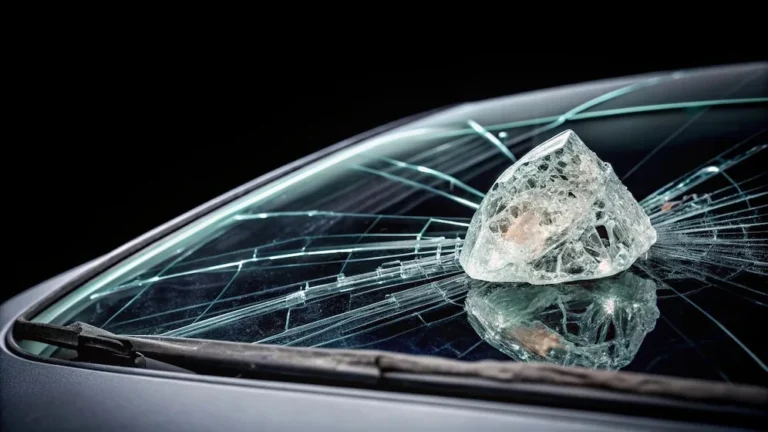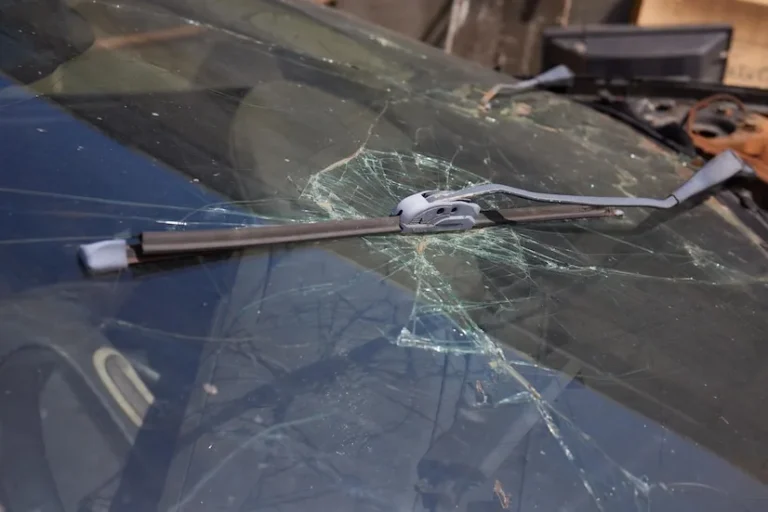Windshield Rock Chip Repair | Professional Services In Austin
Windshield rock chip repair is a crucial service for maintaining the integrity and safety of your vehicle’s glass. These seemingly minor chips and cracks can quickly escalate into more significant damage if not addressed promptly. By taking swift action to repair rock chips, you not only prevent the spread of damage but also ensure your windshield remains structurally sound and clear, which is essential for safe driving. Ignoring these issues can lead to costly replacements and compromise your visibility on the road.
Types And Causes Of Rock Chip Repair

Types of Windshield Chips
When it comes to windshield damage, there are several common types of chips, each with its own characteristics:
Bullseye: This type of chip resembles a small, circular bullseye with a dark center. It typically occurs when a small, round object hits the windshield, causing a central impact point with concentric rings around it.
Star: Star chips are characterized by a central impact point with multiple radiating cracks extending outward, forming a star-like pattern. This type of damage often results from larger impacts and can spread if not repaired promptly.
Half-moon: This chip features a crescent-shaped crack or break. It usually results from a smaller impact that causes a partial, curved chip in the glass. The half-moon shape is less likely to spread compared to other types but still requires attention.
Crack: Unlike chips, cracks are longer and can vary in length and severity. They can start from an impact point or develop independently due to stress or temperature changes. Cracks can compromise the entire windshield’s strength and often require more extensive repairs.
Causes of Rock Chips
Rock chips in windshields can arise from various sources:
Road Debris: Small stones, gravel, or other debris kicked up by vehicles can strike your windshield, causing chips or cracks. This is especially common on highways or poorly maintained roads.
Weather Conditions: Extreme temperatures and weather changes can lead to windshield damage. For example, rapid temperature shifts can cause the glass to expand or contract, making it more susceptible to chips and cracks.
Impact of Driving Habits: Aggressive driving, such as tailgating or frequent lane changes, can increase the likelihood of encountering road debris. Additionally, hitting potholes or uneven surfaces can stress the windshield and lead to damage.
Professional Windshield Chip Repair in Austin

When it comes to windshield chip repair in Austin, choosing a professional service can make all the difference. At Reliable Auto Glass, we pride ourselves on delivering top-notch auto glass service with a commitment to excellence. Here’s why opting for our expert windshield repair or replace service ensures the best results for your vehicle:
Expertise and Equipment
Our skilled technicians are equipped with the latest tools and techniques to handle any chips or cracks in your windshield. With years of experience, we can accurately assess the damage and provide a glass repaired solution that restores your windshield’s strength and clarity.
Quality of Repair
When it comes to chips or cracks, the quality of the repair is crucial. At Reliable Auto Glass, we use high-quality resins and state-of-the-art equipment to ensure a seamless repair. Our goal is to make the damage virtually invisible and to maintain the structural integrity of your windshield.
Warranties and Guarantees
We stand behind our work with comprehensive warranties and guarantees. You can trust that your windshield repair will be performed to the highest standards. If you encounter any issues with the repair, we’re here to make it right.
Don’t let a small chip turn into a costly replacement. Choose Reliable Auto Glass for your windshield repair needs and experience the difference that professional service can make. Contact us today to schedule your appointment!
Tesla Windshield Rock Chip Repair
When it comes to repairing windshield rock chips on Tesla vehicles, there are several unique considerations to keep in mind. Tesla vehicles are known for their advanced technology and high-quality materials, which means that the approach to windshield repair needs to be precise and informed.
Unique Considerations for Tesla Windshield Repairs
Special Glass and Sensors:
- Tesla windshields often have special glass designed for enhanced durability and optimal performance. This glass may also come with built-in sensors for various systems.
- Many Teslas have cameras and sensors embedded in the windshield as part of their Advanced Driver-Assistance Systems (ADAS). These components require careful handling to avoid any damage or misalignment.
Advanced Driver-Assistance Systems (ADAS):
- Tesla’s ADAS features, including Autopilot and Full Self-Driving (FSD), rely on cameras and sensors mounted on the windshield. If these sensors are disturbed or misaligned during a repair, it could affect the vehicle’s performance and safety features.
- After any windshield repair or replacement, it’s crucial to ensure that these systems are recalibrated correctly. Failure to do so could compromise the vehicle’s safety systems.
Why Choose Reliable Auto Glass?
When selecting a company to handle your Tesla windshield repair, consider the following reasons to choose Reliable Auto Glass:
- Expertise with Tesla Vehicles: We are well-versed in the unique requirements of Tesla windshields, including the specific glass types and sensor technologies used. Our technicians are trained to handle Tesla’s advanced systems with the utmost care.
- Precision and Care: Our repair process is designed to maintain the integrity of your windshield’s sensors and glass. We use specialized tools and techniques to ensure that the repair is seamless and does not interfere with your vehicle’s ADAS.
- Calibration Services: We offer comprehensive services that include recalibrating your Tesla’s sensors and cameras after a repair. This ensures that your vehicle’s advanced safety systems remain fully operational and accurate.
- Commitment to Quality: At Reliable Auto Glass, we prioritize customer satisfaction and quality. We understand the importance of maintaining your Tesla’s performance and safety, and we’re dedicated to providing top-notch service.
By choosing Reliable Auto Glass, you can rest assured that your Tesla’s windshield repair will be handled with the highest level of expertise and care, preserving both the functionality and safety of your advanced vehicle.
Windshield Chip Repair Cost
Factors Influencing Repair Costs
Size and Severity of the Chip:
- The size of the chip plays a crucial role in determining repair costs. Smaller chips or cracks are generally less expensive to repair than larger ones.
- The severity also impacts cost; deeper or more complex chips might require additional materials or techniques, raising the repair cost.
Type of Vehicle:
- The type of vehicle can affect repair costs. For instance, luxury or high-end vehicles, like Teslas, often have specialized glass and embedded sensors that require more meticulous handling and can lead to higher repair costs.
- Standard vehicles usually have lower repair costs due to the availability of more common parts and simpler repair procedures.
Location and Service Provider:
- Location influences the cost due to regional differences in labor rates and overhead expenses. Urban areas might have higher prices compared to rural areas.
- The service provider can also impact the cost. Established providers with specialized expertise, like those experienced in handling advanced vehicles, might charge more for their specialized service.
Typical Cost Range
Average Prices for Various Repair Types:
- For a basic chip repair, you can expect to pay between $50 to $100. This typically covers minor chips and cracks that are not extensive.
- For more complex repairs, such as those involving larger or multiple chips, costs may range from $100 to $200. This includes situations where the chip requires more extensive treatment or advanced techniques.
- For luxury or advanced vehicles, like a Tesla, repair costs might be on the higher end of the spectrum due to the specialized nature of the glass and sensor recalibration. Typical costs could range from $150 to $300 or more.
When you repair a chip, it’s important to consider these factors to understand the cost to repair effectively. Always consult with your service provider to get a precise quote based on your specific needs and vehicle type.
FAQs
What is windshield rock chip repair?
Windshield rock chip repair is a process used to fix minor chips and cracks in a vehicle’s windshield caused by road debris. The repair involves injecting a resin into the damaged area to restore the glass’s strength and clarity, preventing further damage and improving the appearance.
How do I know if my windshield chip can be repaired?
Generally, if the chip is smaller than a quarter and hasn’t spread or caused significant cracks, it can usually be repaired. Chips larger than a quarter or those that have spread significantly may require a full windshield replacement.
How long does a windshield rock chip repair take?
The repair process typically takes between 30 minutes to an hour, depending on the size and severity of the chip and the experience of the technician.
Will the repair affect my vehicle’s visibility?
A well-executed repair should improve visibility by making the chip less noticeable and preventing it from spreading. However, it may not restore the glass to its original clarity.
How much does windshield rock chip repair cost?
The cost to repair a windshield rock chip generally ranges from $50 to $100 for standard chips. For more severe damage or luxury vehicles with advanced features, costs may range from $100 to $300 or more. Prices can vary based on location and service provider.
Can I drive my vehicle immediately after a rock chip repair?
Yes, you can typically drive your vehicle immediately after a windshield rock chip repair. However, it’s a good idea to avoid washing the windshield or exposing it to extreme temperatures for at least 24 hours to allow the resin to fully cure.

